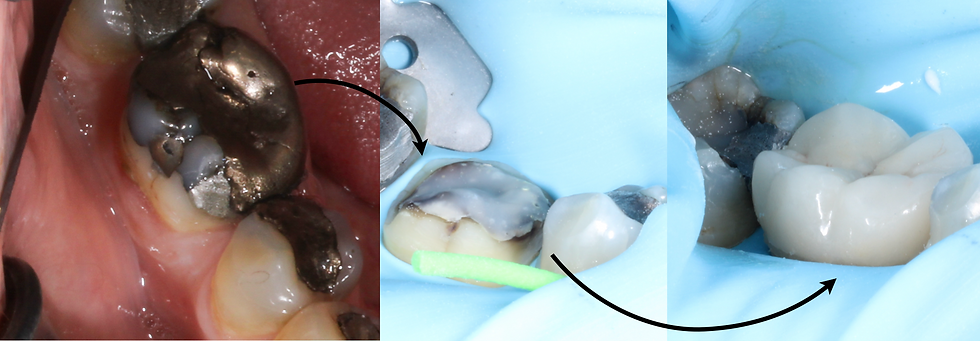Considering a Dental Onlay? Here's What You Need to Know
- Dr. Harriet Beaty

- Jun 12, 2024
- 2 min read
#onlay #crown #restoration #dentalhealth #dentistry #oralhealth #smilemakeover #dentalcare #dentaltreatment #dentalonlay #onlayvscrown #toothrepair #crackedtooth #conservativerestoration #savethetooth #dentalfilling
If your dentist has mentioned an onlay, you might be wondering what it is and if it's the best option for you. Don't worry, this guide will answer all your onlay FAQs!
As a dentist, I frequently recommend onlays to my patients for a few key reasons:
Safeguarding Teeth After Root Canals: Root canal treatment, while necessary to save a tooth, can weaken its overall structure. Onlays act like reinforcements, restoring strength and stability to the tooth. This ensures your tooth can function properly and comfortably for years to come.
Preserving Teeth with Large Fillings: Over time, large fillings, whether made of amalgam or composite, can make teeth more susceptible to fracturing. While we can't predict exactly when this might happen, onlays offer a proactive solution. By placing an onlay on a tooth with a large filling, we reduce this risk of fracture. Large fillings if left can crack unfavourably, meaning we have no way of restoring the tooth.
So, what is a Dental Onlay?
Think of an onlay as a super-filling. It's a custom-made restoration designed to cover a significant portion of your tooth, typically including one or more cusps (the pointed chewing surfaces). Unlike a filling, which fits within the tooth, an onlay bonds to the remaining healthy tooth structure, offering extra strength and support.

Why Choose an Onlay?
Here's where onlays shine:
Preserving Tooth Structure: Compared to crowns, onlays remove less of your natural tooth. This is crucial for long-term oral health and maintaining a strong bite.
Restoring Moderately Damaged Teeth: Onlays are ideal for teeth with extensive decay, large cracks, or existing large fillings that have compromised strength.
Natural-Looking Results: Made from tooth-colored composite resin or porcelain, onlays blend seamlessly with your surrounding teeth for a beautiful, natural smile.
Onlay vs. Crown: What's the Difference?
You may be more familiar with dental crowns, so what's the difference?
Both onlays and crowns address tooth damage, but they differ in how much tooth structure they cover. A crown essentially becomes a new "cap" for the entire tooth, while an onlay focuses on the affected area. Here's a quick comparison:
Feature | Onlay | Crown |
Invasiveness | Less tooth structure removed | More tooth structure removed - this means there is a higher risk the tooth will need a root canal treatment in the future as it is more likely to damage the nerve |
Coverage | Covers only part of the tooth that is damaged - ideal for moderately damaged teeth | Covers the entire tooth, making them more destructive to your natural tooth. They are still used when teeth are severely damaged. |
Material | Porcelain, gold, or composite resin | Porcelain, metal, or ceramic |
Indications | Restoring damaged back teeth | Changing the size and shape of a tooth, replacing a crown, covering a dark tooth |
Where | Back teeth only | All teeth |
Retrievability | If an onlay breaks or the glue breaks down, the tooth is unlikely to be damaged, and another onlay or crown can be placed | Often when a crown breaks or fails, the tooth cannot be saved, and you would need to have an extraction |
The Onlay Procedure: What to Expect
The onlay process typically involves two appointments:
Preparation: During the first visit, your dentist numbs the area, removes any decay or damaged tooth structure, and takes a 3D scan so a laboratory can create a custom, bespoke onlay. A temporary restoration will be placed to protect your tooth until the permanent one is ready.
Placement: On your second visit, your dentist will remove the temporary restoration, ensure the fit of the onlay, and then securely bond it to your tooth using dental cement. After minor adjustments and polishing, your new onlay is ready to go!
Caring for Your Onlay
Onlays are incredibly durable, but good oral hygiene is key. Brush twice daily, floss regularly, and maintain regular dental checkups with both the dentist and hygiene team, to ensure the long lifespan of your onlay.
Talking to Your Dentist
If you're facing tooth damage, discuss onlays with your dentist. They can evaluate your specific situation and determine if an onlay is the right solution for restoring your smile and oral health. By preserving more of your natural tooth structure, onlays offer a valuable option for maintaining a strong, healthy smile.
コメント